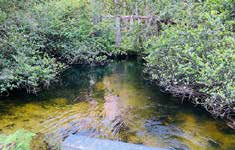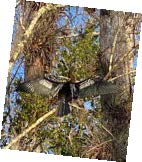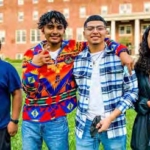Everglades Restoration; Is it really? chickee talk by Tina Osceola
As I sit here writing this month’s article, I am inspired my surroundings. Although the sun is warm, the cool breeze that I feel while sitting under the shade of a chickee, is my idea of paradise. I am at a Seminole camp that is within the Everglades, the home of my
people. The Tamiami Trail cuts through the Everglades with such precision that it seems like the sides of the roads should have sharp edges. Many have written songs and books about the River of Grass, with the endless prairies of sawgrass from one coast to the other. Within eyesight, I see blue herons and egrets, and beyond where my eyes can see, I know there are gators galore.
 Of course, I would be remiss if I didn’t mention that it is my day off from work, so this isn’t something I get to do everyday, as some would think. In fact, when I snap my fingers, I am propelled back into reality. I am forced to acknowledge that although these are our homelands, the Everglades is also a battleground. A battleground between political parties, a fight for federal funding, a fight for water, a fight for clean water, a fight for habitat and for some of us, a fight for indigenous rights. As the Director of the Seminole Tribe of Florida’s Tribal Historic Preservation Office, my team and I spend every waking hour defending tribal sovereignty and the right to call this land our home. Many reliant on the tourism industry are quick to exploit the Seminole and Miccosukee heritage if it brings visitors through their gates, but when it comes to supporting our Tribes’ fight for the preservation of its cultural resources, including the burial sites of our ancestors, we find that we’re standing by ourselves.
Of course, I would be remiss if I didn’t mention that it is my day off from work, so this isn’t something I get to do everyday, as some would think. In fact, when I snap my fingers, I am propelled back into reality. I am forced to acknowledge that although these are our homelands, the Everglades is also a battleground. A battleground between political parties, a fight for federal funding, a fight for water, a fight for clean water, a fight for habitat and for some of us, a fight for indigenous rights. As the Director of the Seminole Tribe of Florida’s Tribal Historic Preservation Office, my team and I spend every waking hour defending tribal sovereignty and the right to call this land our home. Many reliant on the tourism industry are quick to exploit the Seminole and Miccosukee heritage if it brings visitors through their gates, but when it comes to supporting our Tribes’ fight for the preservation of its cultural resources, including the burial sites of our ancestors, we find that we’re standing by ourselves.
 Although, in spirit, I support anything that makes the Everglades environment more healthy, Everglades restoration has always been puzzling to me. Restore the entire ecosystem back to what point in time? Pre-drainage? How do you do that without taking out Tamiami Trail and I-75? Scientists will stand ready with an answer, so that is a bit rhetorical. What do you do with all of the invasive species? How do we ensure that nutrients from invasive species like Brazilian Pepper aren’t in the water that they send… south? That’s the other thing… which direction should the water flow? No one on either coast wants the water to come from Lake Okeechobee because of the blue green algae. That’s understandable… after all, I live in Naples. However, what about those who live South of Lake Okeechobee and are in the pathway to the Gulf? The Seminoles and Miccosukees… the battle for clean water and a restored ecosystem always seems to leave out a major voice… the indigenous voice.
Although, in spirit, I support anything that makes the Everglades environment more healthy, Everglades restoration has always been puzzling to me. Restore the entire ecosystem back to what point in time? Pre-drainage? How do you do that without taking out Tamiami Trail and I-75? Scientists will stand ready with an answer, so that is a bit rhetorical. What do you do with all of the invasive species? How do we ensure that nutrients from invasive species like Brazilian Pepper aren’t in the water that they send… south? That’s the other thing… which direction should the water flow? No one on either coast wants the water to come from Lake Okeechobee because of the blue green algae. That’s understandable… after all, I live in Naples. However, what about those who live South of Lake Okeechobee and are in the pathway to the Gulf? The Seminoles and Miccosukees… the battle for clean water and a restored ecosystem always seems to leave out a major voice… the indigenous voice.
Although it is my job to protect the cultural resources of my Tribe, it is also my responsibility to make sure the Seminole voice is not just spoken, but heard. It is also important that the federal laws responsible for the protection of our cultural and environmental resources are adhered to without fail. Most importantly, however, I also think it’s important that our story is shared. We all love the Everglades, but the people whose lifeblood is as vital as the water, cannot be left out.
 I urge people to visit the Seminole Tribe’s Ah-Tah-Thi-Ki Museum on the Big Cypress Reservation, as well as the numerous Seminole and Miccosukee businesses that dot along Tamiami Trail. The Miccosukee Tribe has a cultural center, village and museum along the Trail that is a must see. Also, please stress to any decision maker or journalist to ask us for our perspective. Our story is so interesting and is a real added dimension to the natural experience of Florida. The National Park Service and other federal agencies have ignored us enough. We stand prepared to tell our story, show you what we consider important, and most of all demonstrate the inextricable relationship between the everglades and our people.
I urge people to visit the Seminole Tribe’s Ah-Tah-Thi-Ki Museum on the Big Cypress Reservation, as well as the numerous Seminole and Miccosukee businesses that dot along Tamiami Trail. The Miccosukee Tribe has a cultural center, village and museum along the Trail that is a must see. Also, please stress to any decision maker or journalist to ask us for our perspective. Our story is so interesting and is a real added dimension to the natural experience of Florida. The National Park Service and other federal agencies have ignored us enough. We stand prepared to tell our story, show you what we consider important, and most of all demonstrate the inextricable relationship between the everglades and our people.




Leave a Reply
Want to join the discussion?Feel free to contribute!